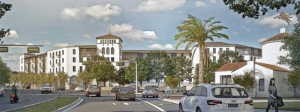APARTMENT BUILDING AND RETAIL SPACE FORM COMPLEX
Ground will not be broken anytime soon, but it appears a four-story mixed-use development will arise in the heart of Alamo Heights. The City Council voted 4-1 on April 13 to approve a special use permit (SUP), with several conditions allowing Argyle Residential to build a 150-apartment-unit building with retail space at Austin Highway and Broadway. The complex would sit atop a mix of land owned privately by Broadway Ellwood Co., a local property ownership group, and by the city of Alamo Heights. The decision follows months of lengthy meetings at City Hall, where many residents have argued against the proposed development. The estimated $22 million project includes an underground parking garage and a triangular piece of land preserved for public green space.
Argyle representatives said they would take stewardship of the green space parcel, which includes right-of-way owned by Bexar County. It’s also a parcel that local developer Glenn Huddleston proposed buying, along with a nearby tract, to keep as public green space in favor of a multi-story building. The council voted also to accept $20 as the per-square-foot price to abandon all five parcels eyed for the project. Some residents had balked at even the idea of the city selling some of its most prominent property to a private development. Argyle has pledged to use its proceeds for improving infrastructure in the immediate area. The council’s decision supports the Alamo Heights Planning and Zoning Commission’s recommendations for the permit allowing construction. One of the key provisions is that Ellwood Street, a short west-east road creating a northern boundary for the land parcels, stay open as a public street. Argyle initially asked that it be closed as part of acquiring public right-of-way and creating a new sense of connectivity with adjacent commercial and residential properties. According to Argyle’s managing partner, John Burnham, the developers could realign Ellwood around the northwestern edge of the project site and upgrade the overall road. Planning and zoning commissioners promise to review the design of a realigned Ellwood Street. Meanwhile, it will take months for the Federal Emergency Management Agency (FEMA) and San Antonio River Authority (SARA) to review how the project could impact the floodplain. Austin Highway and Broadway has been the scene of flash flooding in major rain events in recent years. “I still have deep, deep concerns about flooding there,” said Bobby Hasslocher, the only council member to vote “no” on the SUP.
Sam Dawson’s local firm, Pape-Dawson Engineering, worked with Argyle to study runoff issues in the neighborhood. Dawson said the project could comply with city rules on drainage and impervious cover, and felt assured that FEMA and SARA will give the development their blessings. Most residents speaking their minds April 13 argued against the development. Some said it will be too big for the overall stretch of land that is less than 2 acres large. Others said they worry about how it could affect drainage, the city’s water supply, traffic, pedestrian safety and the local school district. “This isn’t about letting a property owner get to do what he wants. This is about privileged developers who get the rules bent for them,” said Matt Beebe. The number of project supporters was not visibly as high as the number of critics in recent public meetings. But those who have shown up and those who went to a pro-project website – www.progressforalamoheights.com – said the project will jump-start economic development in downtown Alamo Heights. The same proponents said the project would help improve the look of the city’s center, encourage younger individuals and families to live in the area and create a stream of real estate tax revenue for the city. “It’ll be a catalyst for improvements. It has been revised to fit (the city’s desires),” said David Hornberger.
By EDMOND ORTIZ






